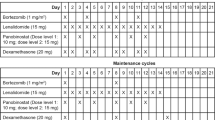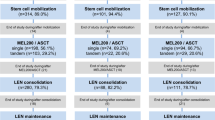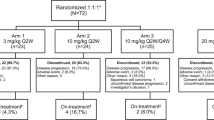Abstract
Single agent bortezomib results in response rates of 51% in patients with newly diagnosed multiple myeloma and is touted to be especially effective in high-risk disease. We are the first to prospectively explore single agent bortezomib as primary therapy (induction, maintenance and re-induction) without consolidative autologous stem cell transplant in a cohort selected to have high-risk multiple myeloma. Patients received eight cycles of induction, followed by maintenance bortezomib every other week, indefinitely. Patients relapsing on maintenance had the full induction schedule resumed. On an intention-to-treat basis, the response rate (⩾partial response) was 48%. Among seven patients who progressed on maintenance bortezomib and received re-induction, two responded to the treatment. With a median follow-up of 48.2 months, 1- and 2-year overall survival probabilities were 88% (95% confidence interval (CI) 79–98%) and 76% (95% CI 60–86%), respectively. Median progression-free survival was 7.9 months (95% CI 5.8–12.0). Twenty-three and thirty-four patients had ⩾grade 3 hematological and non-hematological toxicity, respectively, with treatment-emergent neuropathy in 7% with motor grade 1–2, 56% with sensory grade 1–2 and 2% with grade 3, and in 14% with neuropathic pain grade 1–2 and 2% with grade 3. In high-risk patients, upfront bortezomib results in response rates that are comparable to those reported for unselected cohorts, but single agent bortezomib is not sufficient as primary therapy.
This is a preview of subscription content, access via your institution
Access options
Subscribe to this journal
Receive 12 print issues and online access
$259.00 per year
only $21.58 per issue
Buy this article
- Purchase on Springer Link
- Instant access to full article PDF
Prices may be subject to local taxes which are calculated during checkout



Similar content being viewed by others
References
Rajkumar SV, Buadi F . Multiple myeloma: new staging systems for diagnosis, prognosis and response evaluation. Best Pract Res Clin Haematol 2007; 20: 665–680.
Kumar SK, Rajkumar SV, Dispenzieri A, Lacy MQ, Hayman SR, Buadi FK et al. Improved survival in multiple myeloma and the impact of novel therapies. Blood 2008; 111: 2516–2520.
Kristinsson SY, Landgren O, Dickman PW, Derolf AR, Bjorkholm M . Patterns of survival in multiple myeloma: a population-based study of patients diagnosed in Sweden from 1973 to 2003. J Clin Oncol 2007; 25: 1993–1999.
Dispenzieri A, Rajkumar SV, Gertz MA, Fonseca R, Lacy MQ, Bergsagel PL et al. Treatment of newly diagnosed multiple myeloma based on Mayo Stratification of Myeloma and Risk-adapted Therapy (mSMART): consensus statement. Mayo Clin Proc 2007; 82: 323–341.
Jagannath S, Richardson PG, Sonneveld P, Schuster MW, Irwin D, Stadtmauer EA et al. Bortezomib appears to overcome the poor prognosis conferred by chromosome 13 deletion in phase 2 and 3 trials. Leukemia 2007; 21: 151–157.
San-Miguel JF, Richardson PG, Sonneveld P, Schuster MW, Irwin D, Stadtmauer EA et al. Efficacy and safety of bortezomib in patients with renal impairment: results from the APEX phase 3 study. Leukemia 2008; 22: 842–849.
Blade J, Samson D, Reece D, Apperley J, Bjorkstrand B, Gahrton G et al. Criteria for evaluating disease response and progression in patients with multiple myeloma treated by high-dose therapy and haemopoietic stem cell transplantation. Myeloma Subcommittee of the EBMT. European Group for Blood and Marrow Transplant. Br J Haematol 1998; 102: 1115–1123.
Durie BG, Harousseau JL, Miguel JS, Blade J, Barlogie B, Anderson K et al. International uniform response criteria for multiple myeloma. Leukemia 2006; 20: 1467–1473.
Greipp PR, Lust JA, O’Fallon WM, Katzmann JA, Witzig TE, Kyle RA . Plasma cell labeling index and beta 2-microglobulin predict survival independent of thymidine kinase and C-reactive protein in multiple myeloma. Blood 1993; 81: 3382–3387.
Fonseca R, Bailey RJ, Ahmann GJ, Rajkumar SV, Hoyer JD, Lust JA et al. Genomic abnormalities in monoclonal gammopathy of undetermined significance. Blood 2002; 100: 1417–1424.
Jagannath S, Durie BG, Wolf J, Camacho E, Irwin D, Lutzky J et al. Bortezomib therapy alone and in combination with dexamethasone for previously untreated symptomatic multiple myeloma. Br J Haematol 2005; 129: 776–783.
Harousseau JL, Attal M, Leleu X, Troncy J, Pegourie B, Stoppa AM et al. Bortezomib plus dexamethasone as induction treatment prior to autologous stem cell transplantation in patients with newly diagnosed multiple myeloma: results of an IFM phase II study. Haematologica 2006; 91: 1498–1505.
Rosinol L, Oriol A, Mateos MV, Sureda A, Garcia-Sanchez P, Gutierrez N et al. Phase II PETHEMA trial of alternating bortezomib and dexamethasone as induction regimen before autologous stem-cell transplantation in younger patients with multiple myeloma: efficacy and clinical implications of tumor response kinetics. J Clin Oncol 2007; 25: 4452–4458.
Richardson PG, Xie W, Mitsiades C, Chanan-Khan AA, Lonial S, Hassoun H et al. Single-agent bortezomib in previously untreated multiple myeloma: efficacy, characterization of peripheral neuropathy, and molecular correlations with response and neuropathy. J Clin Oncol 2009; 27: 3518–3525.
Avet-Loiseau H, Attal M, Moreau P, Charbonnel C, Garban F, Hulin C et al. Genetic abnormalities and survival in multiple myeloma: the experience of the Intergroupe Francophone du Myelome. Blood 2007; 109: 3489–3495.
Gertz MA, Lacy MQ, Dispenzieri A, Greipp PR, Litzow MR, Henderson KJ et al. Clinical implications of t(11;14)(q13;q32), t(4;14)(p16.3;q32), and -17p13 in myeloma patients treated with high-dose therapy. Blood 2005; 106: 2837–2840.
Orlowski RZ, Peterson BL, Sanford B, Chanan-Khan AA, Zehngebot LM, Watson PR et al. Bortezomib and pegylated liposomal doxorubicin as induction therapy for adult patients with symptomatic multiple myeloma: Cancer and Leukemia Group B Study 10301. Blood 2006; 108: 797.
Popat R, Oakervee HE, Hallam S, Curry N, Odeh L, Foot N et al. Bortezomib, doxorubicin and dexamethasone (PAD) front-line treatment of multiple myeloma: updated results after long-term follow-up. Br J Haematol 2008; 141: 512–516.
Oakervee H, Popat R, Cavenagh JD . Use of bortezomib as induction therapy prior to stem cell transplantation in frontline treatment of multiple myeloma: impact on stem cell harvesting and engraftment. Leuk Lymphoma 2007; 48: 1910–1921.
Barlogie B, Haessler J, Pineda-Roman M, Anaissie E, van Rhee F, Kiwan E et al. Completion of premaintenance phases in total therapies 2 and 3 improves clinical outcomes in multiple myeloma: an important variable to be considered in clinical trial designs. Cancer 2008; 112: 2720–2725.
San Miguel JF, Schlag R, Khuageva NK, Dimopoulos MA, Shpilberg O, Kropff M et al. Bortezomib plus melphalan and prednisone for initial treatment of multiple myeloma. N Engl J Med 2008; 359: 906–917.
Conner TM, Doan QD, LeBlanc AL, Walters IB, Beveridge RA . An observational, retrospective analysis of retreatment with bortezomib of multiple myeloma (MM) patients. ASH Annu Meet Abstr 2006; 108: 3531.
Hrusovsky I, Emmerich B, Engelhardt M, Kornacker M, Gann C-N, Pliskat H et al. Bortezomib retreatment in relapsed multiple mycelia—a retrospective multicenter survey. ASH Annu Meet Abstr 2007; 110: 2720.
Petrucci MT, Blau IW, Corradini P, Dimopoulos MA, Drach J, Giraldo P et al. Efficacy and safety of re-treatment with bortezomib (Velcade(C)) in patients with multiple myeloma: results from a Prospective International Phase II Trial. Blood (ASH Annu Meet Abstr) 2008; 112: 3690.
Mateos M-V, Richardson PG, Schlag R, Khuageva NK, Dimopoulos MA, Shpilberg O et al. Bortezomib plus melphalan-prednisone continues to demonstrate a survival benefit vs melphalan-prednisone in the Phase III VISTA Trial in previously untreated multiple myeloma after 3 years’ follow-up and extensive subsequent therapy use. ASH Annu Meet Abstr 2009; 114: 3859.
Author information
Authors and Affiliations
Corresponding author
Ethics declarations
Competing interests
The authors declare no conflict of interest.
Rights and permissions
About this article
Cite this article
Dispenzieri, A., Jacobus, S., Vesole, D. et al. Primary therapy with single agent bortezomib as induction, maintenance and re-induction in patients with high-risk myeloma: results of the ECOG E2A02 trial. Leukemia 24, 1406–1411 (2010). https://doi.org/10.1038/leu.2010.129
Received:
Revised:
Accepted:
Published:
Issue Date:
DOI: https://doi.org/10.1038/leu.2010.129
Keywords
This article is cited by
-
Nutlin-3 enhances the bortezomib sensitivity of p53-defective cancer cells by inducing paraptosis
Experimental & Molecular Medicine (2017)
-
Exposure–safety–efficacy analysis of single-agent ixazomib, an oral proteasome inhibitor, in relapsed/refractory multiple myeloma: dose selection for a phase 3 maintenance study
Investigational New Drugs (2016)
-
Meta-analysis of incidence and risk of peripheral neuropathy associated with intravenous bortezomib
Supportive Care in Cancer (2015)
-
Cellular uptake kinetics of bortezomib in relation to efficacy in myeloma cells and the influence of drug transporters
Cancer Chemotherapy and Pharmacology (2015)
-
Review of health-related quality of life data in multiple myeloma patients treated with novel agents
Leukemia (2013)



